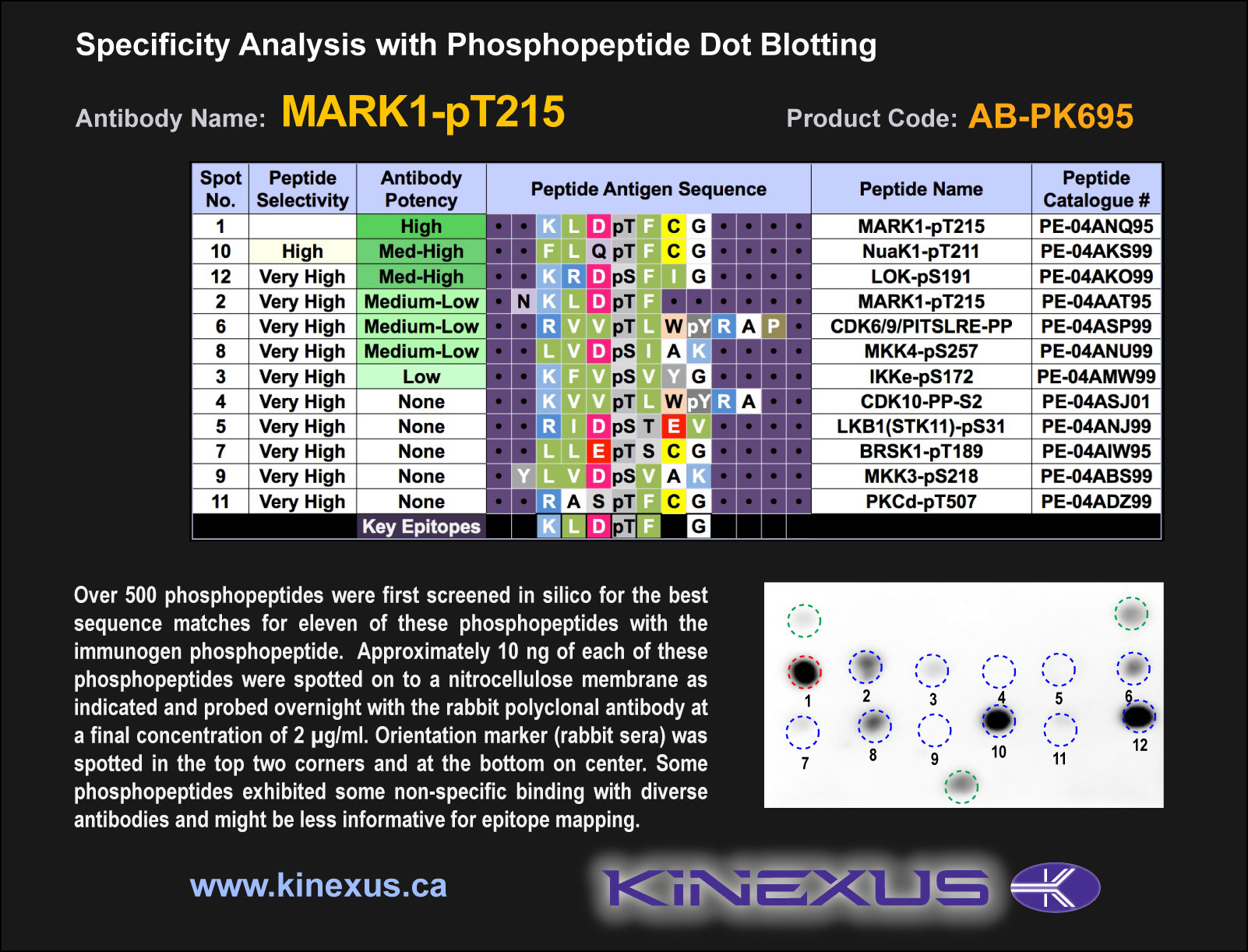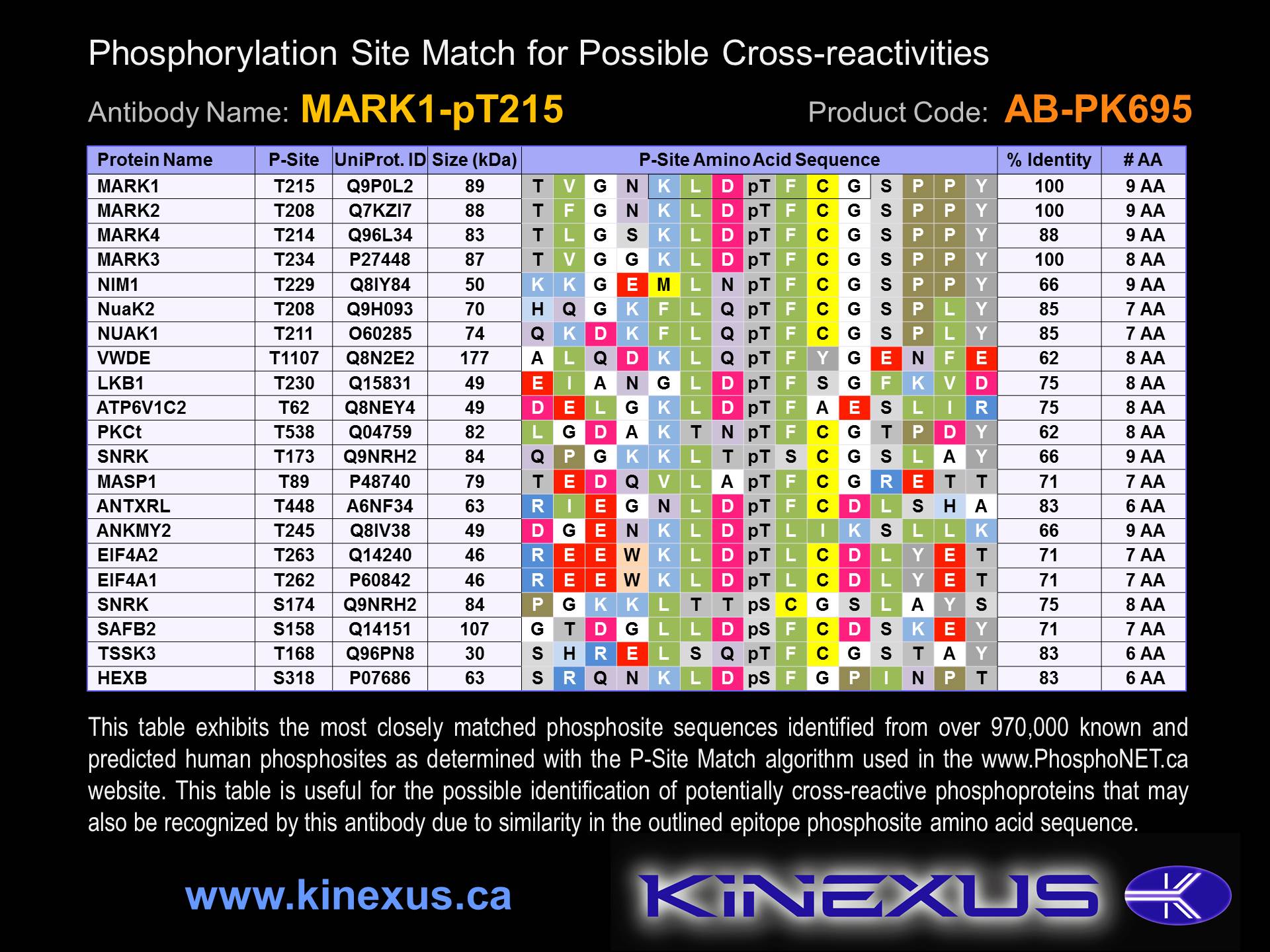Product Name: MARK1-pT215
Product Number: AB-PK695
| Size: | 25 µg | Price: | 89.00 | |
| $US |
Target Full Name: MAP/microtubule affinity-regulating protein-serine kinase 1
Target Alias: ELKL motif kinase 1; EMK; EMK1; Kinase MARK2; MAP/microtubule affinity-regulating kinase 2; MGC99619; PAR-1; Par1b; PAR-1b; Serine/threonine kinase
Product Type Specific: Protein kinase phosphosite-specific antibody
Antibody Code: PK695
Antibody Target Type: Phosphosite-specific
Antibody Phosphosite: T215
Protein UniProt: Q9P0L2
Protein SigNET: Q9P0L2
Antibody Type: Polyclonal
Antibody Host Species: Rabbit
Target Alias: ELKL motif kinase 1; EMK; EMK1; Kinase MARK2; MAP/microtubule affinity-regulating kinase 2; MGC99619; PAR-1; Par1b; PAR-1b; Serine/threonine kinase
Product Type Specific: Protein kinase phosphosite-specific antibody
Antibody Code: PK695
Antibody Target Type: Phosphosite-specific
Antibody Phosphosite: T215
Protein UniProt: Q9P0L2
Protein SigNET: Q9P0L2
Antibody Type: Polyclonal
Antibody Host Species: Rabbit
Antibody Immunogen Source: Human MARK1 sequence peptide Cat. No.: PE-04ANQ95
Antibody Immunogen Sequence: KLD(pT)FCG(bA)C
Antibody Immunogen Description: Corresponds to amino acid residues N211 to F216; In protein kinase catalytic domain activation T-loop between subdomains VII and VIII. This is the major in vivo phosphorylation site in MARK1.
Antibody Immunogen Sequence: KLD(pT)FCG(bA)C
Antibody Immunogen Description: Corresponds to amino acid residues N211 to F216; In protein kinase catalytic domain activation T-loop between subdomains VII and VIII. This is the major in vivo phosphorylation site in MARK1.
Production Method: The immunizing peptide was produced by solid phase synthesis on a multipep peptide synthesizer and purified by reverse-phase hplc chromatography. Purity was assessed by analytical hplc and the amino acid sequence confirmed by mass spectrometry analysis. This peptide was coupled to KLH prior to immunization into rabbits. New Zealand White rabbits were subcutaneously injected with KLH-coupled immunizing peptide every 4 weeks for 4 months. The sera from these animals was applied onto an agarose column to which the immunogen peptide was thio-linked. Antibody was eluted from the column with 0.1 M glycine, pH 2.5. Subsequently, the antibody solution was neutralized to pH 7.0 with saturated Tris.This antibody was also subject to negative purification over phosphotyrosine-agarose.
Antibody Modification: Unconjugated. Contact KInexus if you are interest in having the antibody biotinylated or coupled with fluorescent dyes.
Antibody Modification: Unconjugated. Contact KInexus if you are interest in having the antibody biotinylated or coupled with fluorescent dyes.
Antibody Concentration: 1 mg/ml
Storage Buffer: Phosphate buffered saline pH 7.4, 0.05% Thimerasol
Storage Conditions: For long term storage, keep frozen at -40°C or lower. Stock solution can be kept at +4°C for more than 3 months. Avoid repeated freeze-thaw cycles.
Product Use: Western blotting | Antibody microarray
Antibody Dilution Recommended: 2 µg/ml for immunoblotting
Antibody Potency: Very strong immunoreactivity with immunogen peptide on dot blots.
Antibody Species Reactivity: Human
Antibody Positive Control: The observed molecular mass of the processed target protein on SDS-PAGE gels is reported to be around 85-90 kDa.
Storage Buffer: Phosphate buffered saline pH 7.4, 0.05% Thimerasol
Storage Conditions: For long term storage, keep frozen at -40°C or lower. Stock solution can be kept at +4°C for more than 3 months. Avoid repeated freeze-thaw cycles.
Product Use: Western blotting | Antibody microarray
Antibody Dilution Recommended: 2 µg/ml for immunoblotting
Antibody Potency: Very strong immunoreactivity with immunogen peptide on dot blots.
Antibody Species Reactivity: Human
Antibody Positive Control: The observed molecular mass of the processed target protein on SDS-PAGE gels is reported to be around 85-90 kDa.
Antibody Specificity: High-very high
Related Product 1: MARK1-pT215 blocking peptide
Related Product 2: MARK1-ANT pan-specific antibody (Cat. No.: AB-NK098-2)
Related Product 3: MARK1-pT215 phosphosite-specific antibody (Cat. No.: AB-PK694)
Related Product 5: MARK2-ANT pan-specific antibody (Cat. No.: AB-NK275-1)
Related Product 6: MARK2-BCT pan-specific antibody (Cat. No.: AB-NK275-2)
Related Product 7: MARK3-ANT pan-specific antibody (Cat. No.: AB-NK276-1)
Related Product 8: MARK3-BCT pan-specific antibody (Cat. No.: AB-NK276-2)
Related Product 9: MARK3-pT507 phosphosite-specific antibody (Cat. No.: AB-PK697)
Related Product 1: MARK1-pT215 blocking peptide
Related Product 2: MARK1-ANT pan-specific antibody (Cat. No.: AB-NK098-2)
Related Product 3: MARK1-pT215 phosphosite-specific antibody (Cat. No.: AB-PK694)
Related Product 5: MARK2-ANT pan-specific antibody (Cat. No.: AB-NK275-1)
Related Product 6: MARK2-BCT pan-specific antibody (Cat. No.: AB-NK275-2)
Related Product 7: MARK3-ANT pan-specific antibody (Cat. No.: AB-NK276-1)
Related Product 8: MARK3-BCT pan-specific antibody (Cat. No.: AB-NK276-2)
Related Product 9: MARK3-pT507 phosphosite-specific antibody (Cat. No.: AB-PK697)
Scientific Background: MARK1 is a protein-serine/threonine kinase that is is a member of the CAMK group of protein kinases in the CAMKL family, and MARK subfamily. It mediates control of cell polarity and microtubule function. This kinase is highly expressed and widely distributed in most tested human tissues except apparently in the brain and spinal cord. It is activated by phosphorylation on T215 by STK11 in complex with STE20-related adapter-alpha (STRAD alpha) pseudo kinase and CAB39. MARK1 phosphorylates microtubule-associated proteins and trigger microtubule disruption. Gene mutation studies performed in mice revealed that after targeted disruption of the MARK1 gene, the mice lacked the ability to drink, and displayed hind leg motor dysfunction. Genetic variations in MARK1 have been correlated with susceptibility to autism. MARK1 is over-expressed in the prefrontal cortex of autism patients and affects the function of cortical dendrites. MARK1 has also been linked with the development of gastric adenocarcinomas and ovarian serous carcinomas.
Figure 1. Epitope mapping of MARK1-pT215 antibody with similar phosphopeptides on dot blots.
Figure 2. Identification of phosphosites related to MARK1-pT215.
© Kinexus Bioinformatics Corporation 2017



